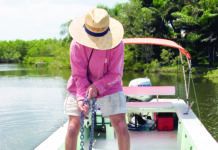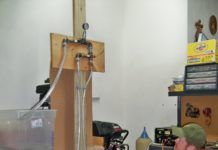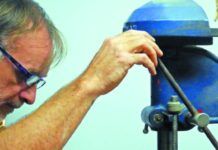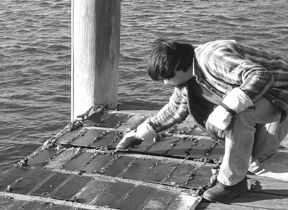
All the land over, commissioning time is fast approaching and boat bottoms are beckoning. At the top of any list of preparations will be “bottom paint,” so here, for the 14th year straight, are Practical Sailor’s ratings of most of the antifouling coatings on the market—54 of them this year, the same as last year, although some of the contestants have changed. As we’ve said before, this would be an absurdly high number of choices, except that no one knows how a particular paint will perform in a particular place and year—there are simply too many variables at play.
Test Procedures
Paints and conditions may vary, but the basic mechanics of our test do not: We buy big sheets of fiberglass each year, and prepare them by de-waxing, sanding, and solvent-washing.
The sheets are taped off into equal-size panels, and the panels are drilled with a six-digit binary code that allows us to identify them no matter how badly fouled they are. The antifouling coatings are brushed on the panels exactly according to manufacturers’ directions.
Unless instructions say otherwise, two coats are applied, with drying times observed. The corners of the sheets are then drilled to accept pendants, and the sheets are then lowered into the water in Connecticut and Florida, where they’re left alone for months on end.
The Connecticut panels were submerged in 2004 from mid-June to mid-December off the end of a dock in a small pleasure-boat harbor in Groton, near the mouth of the Thames River. The water there is clearer and cooler than the water mid-way along the Connecticut shore of Long Island Sound, where we’ve hung the panels the past few years. The tidal current in both places is strong.
In Florida, test sheets were hung from a dock in a clear, saltwater canal in Key Largo. This was a return to the east coast of Florida after a trial year in Sarasota, where the estuary in which the sheets were suspended turned out to be too hypoxic to yield good results on the coatings. The Key Largo sheets also went into the water in mid-June, 2004, and were removed in mid-January, 2005, so they were submerged for a month longer than the Connecticut panels.
The Ratings
Uniformity in the density of fouling on the majority of the panels in recent years has made it tough for evaluators to rate the coatings in an absolute way. All these coatings, judged by the criteria of even a decade ago, would be called excellent. So the middle ratings of Fair and Good need plus and minus qualifiers in order to differentiate a little bit between most of the paints. Even then, these ratings are subjective, and are simply based on agreement among the evaluators. The two extreme ratings are more easily given: Poor means a panel that is essentially obscured in slime; Excellent means the panel is essentially free from any fouling. Among the Connecticut panels there were no Poor ratings, but a bell curve of ratings from Fair-minus to Good, one Good+ and no Excellent ratings.
Connecticut Results
In Connecticut this year, the unpainted backs of the panels emerged completely fouled with slime, a bit of weed, and about 20 to 50 lbs. each of the heavy, flabby, squirty, bladder-like bags known as sea grapes. They’re an invasive species, molgula manhattensis—(we can guess where they came from). Also a fair number of sea squirt colonies (didemnum lahillei). They’re organisms only a marine biologist or a seagull could love. In fact, we had to share the dock with a couple of big gulls, known locally as Sky Rats. They waited for us to step away from the panels for a few seconds, then swooped down to dig into the squirters.
The painted sides of the panels were a different story. There were no sea grapes or weed, and no hard fouling at all—no barnacles, and none of the quarterdeck shells (crepidula fornicata) we’ve seen occasionally in recent years when the panels were located farther west. The only fouling was brown slime, and even then at a concentration that could easily be wiped off any panel with a sponge
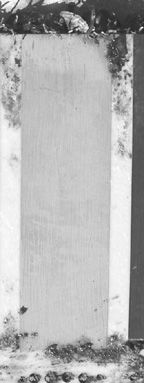
Florida Results
The panels in Florida were much cleaner than the panels in Connecticut. As you see in the chart, seven paints came away with Excellent ratings in Florida, while none was good enough to attain that rating in Connecticut.
And in Florida, 10 of the paints garnered Good+ ratings, which means they had very little soft growth. In addition, only two paints received Fair- ratings.
The water at our test site in Florida is very salty, too. It’s a canal that’s fed with clean, clear water from the Atlantic, which is only about a quarter-mile away.
Unlike in Connecticut, there were no sea grapes attached to the bare spots on these panels, either.
Newcomers
We had a few new paints. From Pettit there’s Vivid, which we’ll reported on in greater detail in our April issue.
Interlux’s highly touted Micron 66 became available to consumers in 2004. We are currently evaluating it on one of our test boats against Pettit’s Trinidad SR. We’ll report on that evaluation in a future issue. Interlux dropped its Komposition bottom paint. And Super Shipbottom opted not to participate in this year’s test because this paint is meant for multiple seasons and the company felt our one-year results did not do the paint justice.
Blue Water paints were back for the second consecutive year, and one of the paints did very well in both Florida and Connecticut. We also added another paint from E Paint—EP-21—which is a less expensive ablative paint available in white or gray. It utilizes zinc Pyrithione like the two other paints in our test from E Paint—EP 2000 and ZO.
Conclusions
The top paints from last year were bested by lesser-known coatings. Micron 66 got an Excellent rating in Florida, but came away with only a Fair in Connecticut. And Pettit’s Trinidad SR, another top performer last year, scored Fairs in both locales. E Paint’s EP 2000 did very well last time, but didn’t separate itself from the others this time.
The best paints in this year’s test are those that scored well in both Florida and Connecticut waters. Clearly, the top performer was Interlux Trilux II, an ablative coating with cuprous thiocyanate, specifically designed for underwater aluminum, but compatible with fiberglass and wood. Trilux II received an Excellent rating in Florida and a Good+ in Connecticut. It is approved for use in Canada, but unfortunately not in the U.S.
The next best are Pettit’s Hydrocoat and Blue Water’s Copper Shield SCX 45. Both paints were given Good+ ratings in Florida and Good ratings in Connecticut.
The Best Buy, at only $44.99 per gallon, is Sea Bowld Coastal Plus made by Pettit and sold at Boater’s World. This paint received respectable ratings—Good in Florida and Fair in Connecticut.
Also considered good buys are Bottomkote XXX, Epoxycop, West Marine CPP, Fiberglass Bottomkote, West Marine Bottom shield, and Tarr & Wonson Copper Paint.
Also With This Article
“Value Guide: Bottom Paints 2005”
“The Hole Code: A Love/Hate Relationship”
Contacts
• Blue Water Marine Paint, 800/628-8422, www.bluewatermarinepaint.com
• E-Paint Company, 800/258-5998, www.epaint.net
• Flexdel Corp., 888/353-9335, www.aquagard-boatpaint.com
• Interlux Yacht Finishes, 800/468-7589, www.yachtpaint.com
• Kop-Coat (Pettit, Woolsey), 800/221-4466, www.kop-coat.com
• New Nautical Coatings, 800/528-0997, www.seahawkpaints.com
• SeaLife Corp., 301/338-9757, www.sealife1000.com
• West Marine, 800/BOATING, www.westmarine.com
• Boater’s World, 800/826-BOAT, www.boatersworld.com











